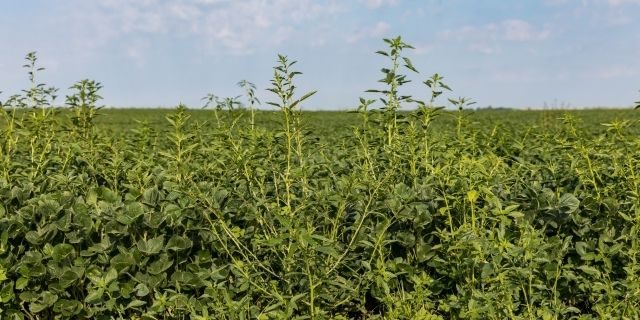15
Dec
Waterhemp: Herbicide Resistant Plant Created by Chemical-Intensive Farming Competes with Crops

(Beyond Pesticides, December 15, 2022) Industrial agriculture has both created and amplified the spread of the now highly problematic waterhemp (Amaranthus tuberculatus) plant, according to research published this month in the journal Science. Over the last 80 years, the push to increase monoculture plantings, expand cropland, and utilize chemical fertilizers and pesticides has changed waterhemp from a tame riparian wild plant into an aggressive, weedy intruder able to compete with row crops like corn and soybean. “The genetic variants that help the plant do well in modern agricultural settings have risen to high frequencies remarkably quickly since agricultural intensification in the 1960s,” said study author Julia Kreiner, PhD with the University of British Columbia’s Department of Botany. “The types of changes we’re imposing in agricultural environments are so strong that they have consequences in neighbouring habitats that we’d usually think were natural.”
To better understand how this plant went from a waterside obscurity to North America’s most notorious “weed,” researchers tracked the shifts occurring within the plants genome. Using data from herbarium samples first collected in 1828 until 2011, scientists sought out alleles (genetic mutations) that corresponded with agricultural intensification and analyzed the frequency of their occurrence over the nearly two centuries of records.
Mutations favored by intensive farming practices were identified by determining genes that were overrepresented in plants found at agricultural sites, compared to its natural riparian habitat. The 154 agriculturally associated alleles corresponded for reproduction, growth and development, plant metabolism, and responses to stimuli, including chemical stimuli such as herbicides. Scientists found chemical adaptation to be the most significant driver of genetic shifts. Many of the changes found are analogous to the sort of selection that plant breeders seek –including faster development and adaptation to high-stress, high disturbance environments.
“While waterhemp typically grows near lakes and streams, the genetic shifts that we’re seeing allow the plant to survive on drier land and to grow quickly to outcompete crops,” said coauthor Sarah Otto, PhD. “Waterhemp has basically evolved to become more of a weed given how strongly it’s been selected to thrive alongside human agricultural activities.”
Directly alongside rapid changes in land use and the rise of industrial agriculture came a significant increase in the frequency of mutations associated with intensive farming practices. While waterhemp in natural environments saw the frequency of these mutations increase by 6% since the 1870s, waterhemp in agricultural environments had these mutations increase by 22%. This is well above natural genetic shifts that models predict would occur without the pressure of intensive agricultural practices on the plant.
Scientists determined that although significant changes had occurred since the 1870s, mutations in both agricultural and natural habitats were negligible until the 1960s. The authors note that, “Change subsequent to 1960 nearly completely accounts for the observed rise in frequency of modern agricultural alleles.” Only the advent of widespread herbicide use explains this shift.
“Modern farms impose a strong filter determining which plant species and mutations can persist through time,” said Dr. Kreiner. “Sequencing the plant’s genes, herbicides stood out as one of the strongest agricultural filter determining which plants survive and which die.”
Each year since 1960, waterhemp plants carrying mutations ascribed to herbicide resistance reproduced 1.2x more than plants without those mutations.
Waterhemp’s ability to withstand herbicides is only increasing. A study published in 2018 found that waterhemp on Missouri croplands were resistant to six different herbicides of different classes. In fact, a 2021 study found that waterhemp displayed herbicide resistance stronger than commercial crops, and was even found to have resistance to herbicides it had never encountered before.
The findings are somewhat similar to what is currently occurring with “weedy rice,” a form of rice that was “re-wilded,” or “de-domesticated” from cultivated rice. In the early 2000s, multinational chemical corporation BASF developed a line of rice cultivars, produced through traditional breeding, that conferred resistance to imidazolinone class herbicides. Now, that line of rice is interbreeding with rewilded weedy rice, resulting in hybrid weedy rice that is placing significant economic costs on farmers throughout the United States.
The solution to this crisis is simple; we must stop the rampant use of toxic chemicals in agriculture and move toward safer solutions. By deindustrializing agricultural production, removing unnecessary synthetic inputs in favor of natural products supported by practices that work with, rather than against existing ecological processes we can forge a sustainable path for the future. Organic production is already showing these benefits and a proof of concept, as the 40 year Rodale Organic Systems Trial finds organic production to be more profitable with competitive yields that do better in drought periods, benefit the climate, and do not result in runoff of toxic pesticides to nearby natural lands.
For more information on the benefits of organic production, see Beyond Pesticides page “Why Organic?”
All unattributed positions and opinions in this piece are those of Beyond Pesticides.
Source: University of British Columbia press release, Science










